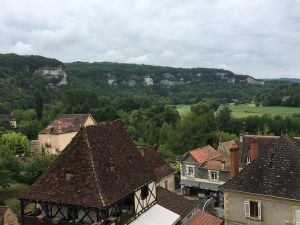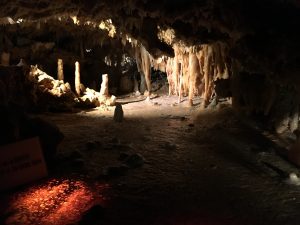I didn’t realize when I selected Les Eyzies as a place to stop that it would offer so very much to see and do. I simply wanted a place in Dordogne since I had heard it was a wonderful region for walks. So imagine my surprise when I arrived yesterday afternoon to find the street full of people, the confluence of rivers offering camping and water activities and a history going back to prehistoric times.
The Vezere valley was a major center of occupation for human groups, beginning over 400,000 years ago. It’s a micro climate and had an abundance of natural resources so in addition to the hunting, fishing and gathering , the Neanderthal and Cro-Magnon Man found shelters in the limestone cliffs in the valley. Over the centuries sedimentation and limestone falls at the foot of the cliffs covered or sealed off many of these prehistoric sites, which provided favorable conditions for fossilization of both biological remains and of various objects. These discoveries have permitted archeologists to further preserve and study caves and paintings and objects. Fifteen of dozens of sites have been recognized by UNESCO; the whole valley is a cradle of European civilization.
First stop this morning was the National Prehistoric Museum, a new building built into the side of a cliff, which I had first thought might’ve been an old building renovated. While not the case, the location and views from the terrace were amazing in and of themselves, as it sits above the village. It tells the story of origins of humans and routes of migration through Europe, and has an extensive display of various tools and other objects created by humans in the millenia they lived in the valley. While impressive, I sorta got a bit lost between the Paleolithic and Neolithic periods. 400,000 years is a lot to cover in one museum visit.
From there I took a long walk to the Grand Roc, just about a mile + out of town. This is a prehistoric rock shelter used by Cor-Magnon man over 15,000 years ago. The cave was discovered in 1922, and opened to the public just 5 years later, and is a true mineral forest, including crystallizations and flowstones and stalactites and stalagmites. It’s necessary to enter with a guide and the interior has had some lights installed to show off the strange beauty of the formations.
On the same side of the river was the L’abri du poisson, a series of caves that contain exceptional artworks dated to 25,000 years ago. One piece, a sculpted and engraved salmon, attests to the importance of fishing in the valley. Now closed, to protect the cave and the art from the destructive human gasses, it is closed for viewing, but the railings to the entrance to the cave are still in place.
After a walk back to town I had a relaxing late afternoon and evening, getting ready for another day tomorrow. Photos at the end are of my hotel in this charming little village.














I love the shots of rocks, caves and cliffs!